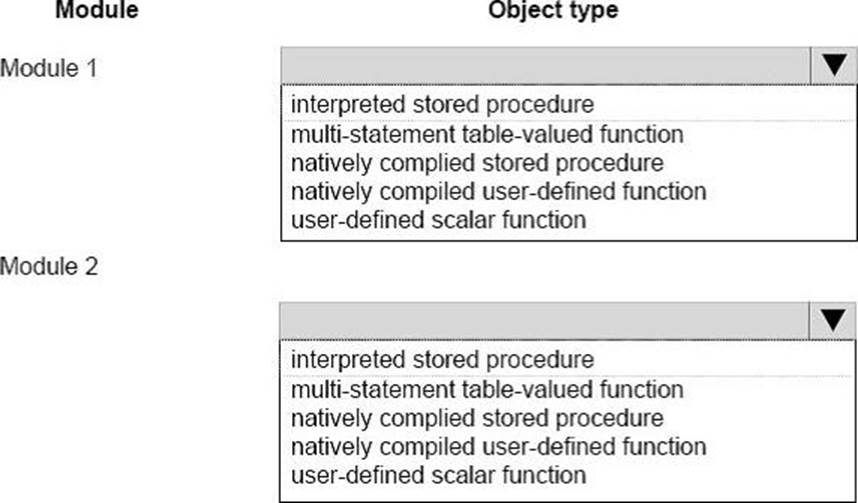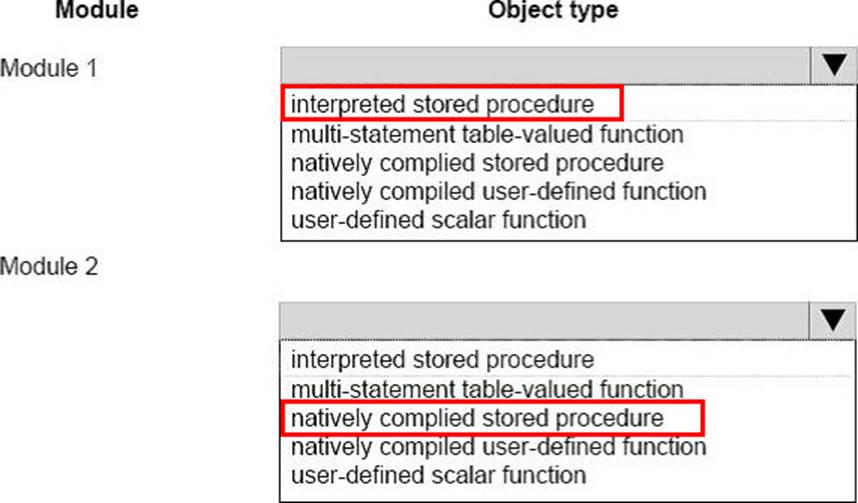Microsoft 70-762 Developing SQL Databases Online Training
Microsoft 70-762 Online Training
The questions for 70-762 were last updated at Jan 21,2025.
- Exam Code: 70-762
- Exam Name: Developing SQL Databases
- Certification Provider: Microsoft
- Latest update: Jan 21,2025
HOTSPOT
You have a database that contains both disk-based and memory-optimized tables. You need to create two modules.
The modules must meet the requirements described in the following table.

Which programming object should you use for each module? To answer, select the appropriate object types in the answer area.

HOTSPOT
You have a database that contains both disk-based and memory-optimized tables. You need to create two modules.
The modules must meet the requirements described in the following table.

Which programming object should you use for each module? To answer, select the appropriate object types in the answer area.

HOTSPOT
You have a database that contains both disk-based and memory-optimized tables. You need to create two modules.
The modules must meet the requirements described in the following table.

Which programming object should you use for each module? To answer, select the appropriate object types in the answer area.

Users must be able to retrieve an account number by supplying customer information.
You need to implement the design changes while minimizing data redundancy.
What should you do?
- A . Split the table into three separate tables. Include the AccountNumber and CustomerID columns in the first table. Include the CustomerName and Gender columns in the second table. Include the AccountStatus column in the third table.
- B . Split the table into two separate tables. Include AccountNumber, CustomerID, CustomerName and Gender columns in the first table. Include the AccountNumber and AccountStatus columns in the second table.
- C . Split the table into two separate tables, Include the CustomerID and AccountNumber columns in the first table. Include the AccountNumber, AccountStatus, CustomerName and Gender columns in the second table.
- D . Split the table into two separate tables, Include the CustomerID, CustomerName and Gender columns in the first table. Include AccountNumber, AccountStatus and CustomerID columns in the second table.
Users must be able to retrieve an account number by supplying customer information.
You need to implement the design changes while minimizing data redundancy.
What should you do?
- A . Split the table into three separate tables. Include the AccountNumber and CustomerID columns in the first table. Include the CustomerName and Gender columns in the second table. Include the AccountStatus column in the third table.
- B . Split the table into two separate tables. Include AccountNumber, CustomerID, CustomerName and Gender columns in the first table. Include the AccountNumber and AccountStatus columns in the second table.
- C . Split the table into two separate tables, Include the CustomerID and AccountNumber columns in the first table. Include the AccountNumber, AccountStatus, CustomerName and Gender columns in the second table.
- D . Split the table into two separate tables, Include the CustomerID, CustomerName and Gender columns in the first table. Include AccountNumber, AccountStatus and CustomerID columns in the second table.
Users must be able to retrieve an account number by supplying customer information.
You need to implement the design changes while minimizing data redundancy.
What should you do?
- A . Split the table into three separate tables. Include the AccountNumber and CustomerID columns in the first table. Include the CustomerName and Gender columns in the second table. Include the AccountStatus column in the third table.
- B . Split the table into two separate tables. Include AccountNumber, CustomerID, CustomerName and Gender columns in the first table. Include the AccountNumber and AccountStatus columns in the second table.
- C . Split the table into two separate tables, Include the CustomerID and AccountNumber columns in the first table. Include the AccountNumber, AccountStatus, CustomerName and Gender columns in the second table.
- D . Split the table into two separate tables, Include the CustomerID, CustomerName and Gender columns in the first table. Include AccountNumber, AccountStatus and CustomerID columns in the second table.
Users must be able to retrieve an account number by supplying customer information.
You need to implement the design changes while minimizing data redundancy.
What should you do?
- A . Split the table into three separate tables. Include the AccountNumber and CustomerID columns in the first table. Include the CustomerName and Gender columns in the second table. Include the AccountStatus column in the third table.
- B . Split the table into two separate tables. Include AccountNumber, CustomerID, CustomerName and Gender columns in the first table. Include the AccountNumber and AccountStatus columns in the second table.
- C . Split the table into two separate tables, Include the CustomerID and AccountNumber columns in the first table. Include the AccountNumber, AccountStatus, CustomerName and Gender columns in the second table.
- D . Split the table into two separate tables, Include the CustomerID, CustomerName and Gender columns in the first table. Include AccountNumber, AccountStatus and CustomerID columns in the second table.
Users must be able to retrieve an account number by supplying customer information.
You need to implement the design changes while minimizing data redundancy.
What should you do?
- A . Split the table into three separate tables. Include the AccountNumber and CustomerID columns in the first table. Include the CustomerName and Gender columns in the second table. Include the AccountStatus column in the third table.
- B . Split the table into two separate tables. Include AccountNumber, CustomerID, CustomerName and Gender columns in the first table. Include the AccountNumber and AccountStatus columns in the second table.
- C . Split the table into two separate tables, Include the CustomerID and AccountNumber columns in the first table. Include the AccountNumber, AccountStatus, CustomerName and Gender columns in the second table.
- D . Split the table into two separate tables, Include the CustomerID, CustomerName and Gender columns in the first table. Include AccountNumber, AccountStatus and CustomerID columns in the second table.
Users must be able to retrieve an account number by supplying customer information.
You need to implement the design changes while minimizing data redundancy.
What should you do?
- A . Split the table into three separate tables. Include the AccountNumber and CustomerID columns in the first table. Include the CustomerName and Gender columns in the second table. Include the AccountStatus column in the third table.
- B . Split the table into two separate tables. Include AccountNumber, CustomerID, CustomerName and Gender columns in the first table. Include the AccountNumber and AccountStatus columns in the second table.
- C . Split the table into two separate tables, Include the CustomerID and AccountNumber columns in the first table. Include the AccountNumber, AccountStatus, CustomerName and Gender columns in the second table.
- D . Split the table into two separate tables, Include the CustomerID, CustomerName and Gender columns in the first table. Include AccountNumber, AccountStatus and CustomerID columns in the second table.
Users must be able to retrieve an account number by supplying customer information.
You need to implement the design changes while minimizing data redundancy.
What should you do?
- A . Split the table into three separate tables. Include the AccountNumber and CustomerID columns in the first table. Include the CustomerName and Gender columns in the second table. Include the AccountStatus column in the third table.
- B . Split the table into two separate tables. Include AccountNumber, CustomerID, CustomerName and Gender columns in the first table. Include the AccountNumber and AccountStatus columns in the second table.
- C . Split the table into two separate tables, Include the CustomerID and AccountNumber columns in the first table. Include the AccountNumber, AccountStatus, CustomerName and Gender columns in the second table.
- D . Split the table into two separate tables, Include the CustomerID, CustomerName and Gender columns in the first table. Include AccountNumber, AccountStatus and CustomerID columns in the second table.
Latest 70-762 Dumps Valid Version with 157 Q&As
Latest And Valid Q&A | Instant Download | Once Fail, Full Refund


